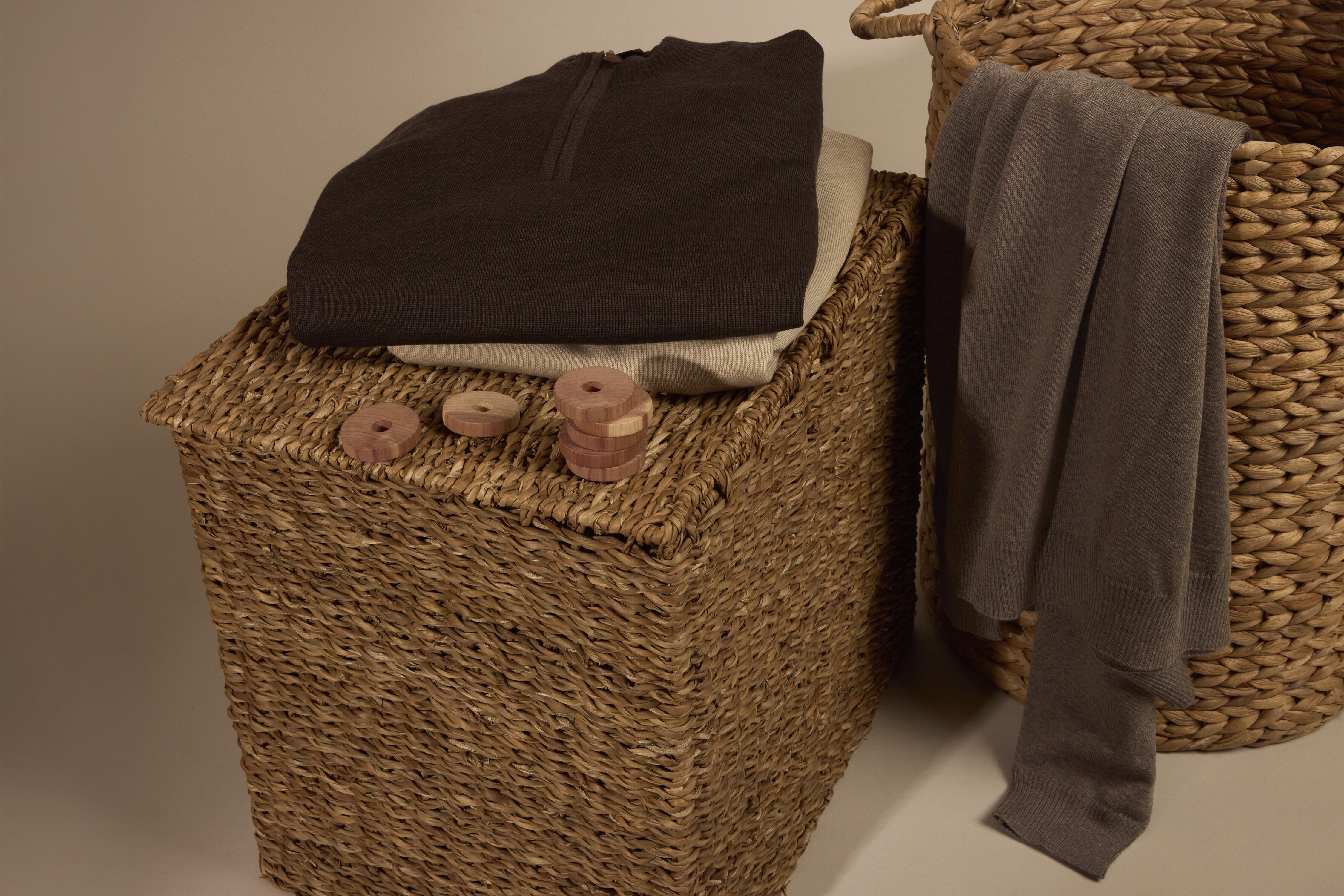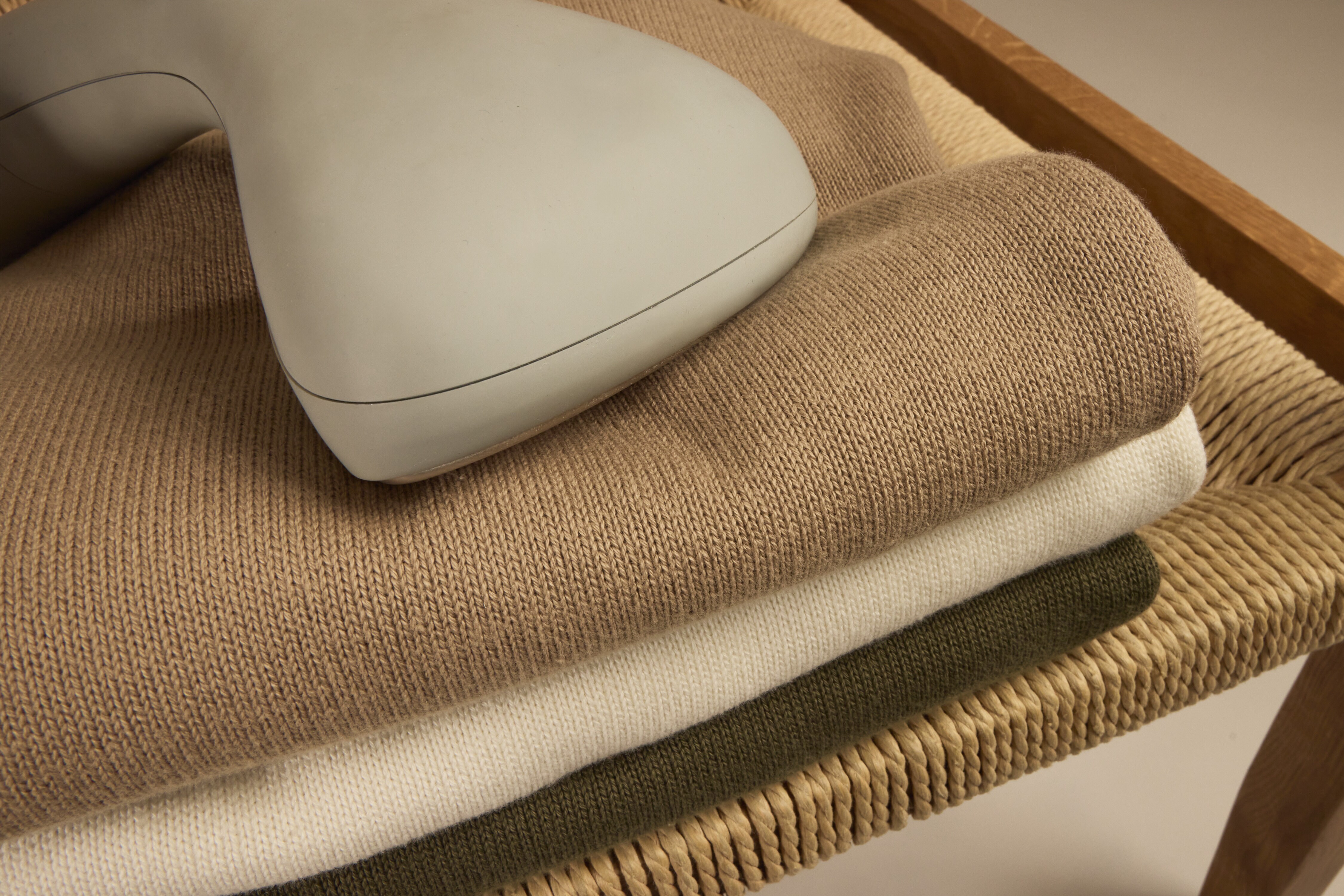Our garments are designed to last. With the right care, you can extend the life of your favorite pieces, keeping them in perfect condition season after season. Here, we’ve gathered our best tips on how to wash, dry and store your knitted garments in different materials.
Country & Language
Knitwear
Merino Wool Cashmere Cotton
Merino wool
Wash: Wool has self-cleaning properties, which means that wool garments rarely need to be washed. The scale-like structure of the wool fibers and the natural fat lanolin, that encapsulates the fibers, make the surface of the material dirt-repellent. Air your garment after use or brush off dust and fuzz with a clothes brush if necessary. This is more friendly for both the garment and the environment.
If you need to wash your knitted wool garment, be careful and follow the advice on the attached care label. Typically, hand wash in cold water is recommended. Choose a delicate detergent suitable for wool. It’s important that it doesn’t contain bleach or enzymes, as these substances risk breaking down the wool fibers. If wool is exposed to a washing machine’s standard program where the spin cycle is set to a high speed, the fibers will rub too hard against each other, leading to felting and shrinking. Your textured knitted garments should, if machine washing is recommended, always be washed separately
in a laundry bag.
Dry: After washing, never wring or squeeze the water out, as this may cause the garment to lose its shape. Instead, place the garment on a dry, clean towel and roll it up to remove excess water. Then, gently reshape the garment and lay it flat to dry until it’s completely dry.
If your wool garment needs ironing, use a steam iron on low heat and place a towel in between. You may also freshen it up using a steamer.
Store: Knitwear should be stored folded and not stacked too heavily on top of each other. Knitted garments that are hung on a hanger risk being stretched out by their own weight and the hangers may leave marks. Keep pests away by placing cedarwood near your wool garments. Cedarwood gives a lovely scent to the wardrobe and is disliked by moths and carpet beetles. Make sure not to place the cedarwood directly on to the garments, as it can leave stains. It may also be a good idea to use vacuum bags to store the wool garments you won’t be using during the warmer season.
Please note: Neither a wool comb, nor a fabric shaver, shall be used on fine-knit merino wool garments. These tools risk tearing or snagging the delicate fibers, which can damage the garment.
Cashmere
Also applies to heavy knitted garments in yak, alpaca and silk/cashmere mix
Wash: Wool has self-cleaning properties, and the scale-like structure of the wool fibers make the surface of the material dirt-repellent. Therefore, wool garments rarely need to be washed. Air your garment after use or brush off dust and fuzz with a clothes brush if necessary. This is more friendly for both the garment and the environment. If you need to wash your knitted wool garment, be careful and follow the advice on the attached care label. Typically, hand wash in cold water is recommended. Choose a delicate detergent suitable for wool. It’s important that it doesn’t contain bleach or enzymes, as these substances risk breaking down the wool fibers. If wool is exposed to a washing machine’s standard program where the spin cycle is set to a high speed, the fibers will rub too hard against each other, leading to felting and shrinkage. Your textured knit garments should, if machine washing is recommended, always be washed separately in a laundry bag.
Dry: After washing, never wring or squeeze the water out, as this may cause the garment to lose its shape. Instead, place the garment on a dry, clean towel and roll it up to remove excess water. Then, gently reshape the garment and lay it flat to dry until it’s completely dry. If your wool garment needs ironing, use a steam iron on low heat and place a towel in between. You may also freshen it up using a steamer.
Store: Knitwear should be stored folded and not stacked too heavily on top of each other. Knitted garments that are hung on a hanger risk being stretched out by their own weight and the hangers may leave marks. Keep pests away by placing cedarwood near your wool garments. Cedarwood gives a lovely scent to the wardrobe and is disliked by moths and carpet beetles. Make sure not to place the cedarwood directly on to the garments, as it can leave stains. It may also be a good idea to use vacuum bags to store the wool garments you won’t be using during the warmer season.
Remove pilling: Pilling is a natural process caused by excess fibers reaching the surface of the knitted garment. Cashmere, silk/cashmere blends, yak and alpaca wool contain more excess fibers than other materials. That is why they tend to pill more when you first start wearing a new garment. Pilling occurs mostly in areas where the garment is exposed to friction. Therefore, you’ll most likely to find pilling on the sides of your sweater, in the armhole and along the sleeves, where your desk, a seatbelt or your bag might rub against the surface.
Pilling can easily be removed by hand or with the use of a wool comb. Place the garment on a flat surface and comb in one direction to gently remove the pills. A high-quality fabric shaver may also be used. After this process, your garment will look like new again, and over time you’ll notice less pilling.
Cotton
Wash: For our knitted cotton garments, we recommend gentle washing in cold water, not above 30°C, with a low spin cycle. This way, the color will withstand fading.
If the garment isn’t stained, airing after use is a friendlier option for both the garment and the environment.
Dry: After washing, never wring or squeeze the water out, as this may cause the garment to lose its shape. Instead, place the garment on a dry, clean towel and roll it up to remove excess water. Then, gently reshape the garment and lay it flat to dry until it’s completely dry.
If your knitted cotton garment needs ironing, use a steam iron on low heat and place a towel in between. You may also freshen it up using a steamer.
Store: Knitwear should be stored folded and not stacked too heavily on top of each other. Knitted garments that are hung on a hanger risk being stretched out by their own weight and the hangers may leave marks.
-16-7.jpg?extend=copy&width=280&method=fit&height=123&sigma=2.5&minampl=0.5&quality=30&type=auto)
-16-7.jpg)











